Meilleures ventes
-
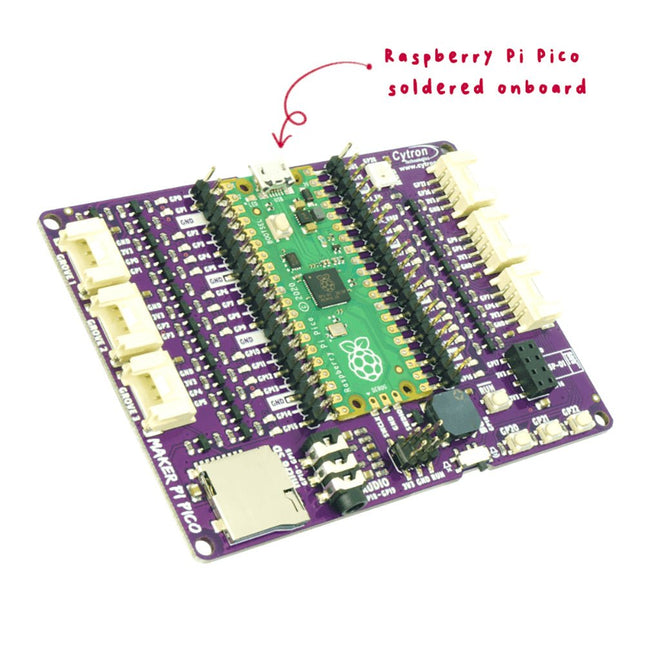
Cytron Cytron Maker Pi Pico (avec Raspberry Pi Pico prémonté)
Le Cytron Maker Pi Pico (avec Raspberry Pi Pico RP2040 soudé sur la carte) intègre les fonctionnalités les plus recherchées pour votre Raspberry Pi Pico et vous donne accès à toutes les broches GPIO sur deux connecteurs à 20 voies, avec des étiquettes claires. Chaque GPIO est associée à un indicateur LED pour faciliter le test et le débogage du code. Le diagramme de brochage indiquant la fonction de chaque broche est imprimé sur la face inférieure de la carte. Fonctions Fonctionne dès la sortie de la boîte. Pas de soudures à faire ! Accès à toutes les broches du Raspberry Pi Pico sur deux connecteurs de 20 voies. Indicateurs LED sur tous les connecteurs GPIO 3x bouton poussoir programmable (GP20-22) 1x LED RVB - NeoPixel (GP28) 1x buzzer piézoélectrique (GP18) 1x prise audio stéréo 3,5 mm (GP18-19) 1x connecteur pour carte Micro SD (GP10-15) 1x connecteur ESP-01 (GP16-17) 6x port Grove Spécifications Coeur 2x ARM Cortex-M0+ 32 bits Horloge du CPU 48 MHz, jusqu'à 133 MHz Taille de la flash Flash Q-SPI de 2 MByte Langage de programmation MicroPython, C++ Alimentation de la carte 5 VCC via MicroUSB Alimentation alternative de la carte 2-5 VCC via le connecteur VSYS (broche 39) Tension de l’unité centrale 3,3 VCC Tension GPIO 3,3 VCC Interface USB Hôte USB 1.1 Changement de programme MicroUSB, stockage de masse USB GPIO 26x Entrée/Sortie ADC 3x 12-bit 500 ksps Capteur de témpérature Intégré, 12 bits UART 2x UART I²C 2x I²C SPI 2x SPI PWM 16x PWM Minuterie 1x Minuterie avec 4 x Alarme Horloge temps réel 1x Horloge temps réel PIO 2x E/S haute vitesse programmables LED embarquée 1x LED programmable Bouton intégré 1x Bouton BOOTSEL
€ 24,95€ 19,95
Membres identique
-
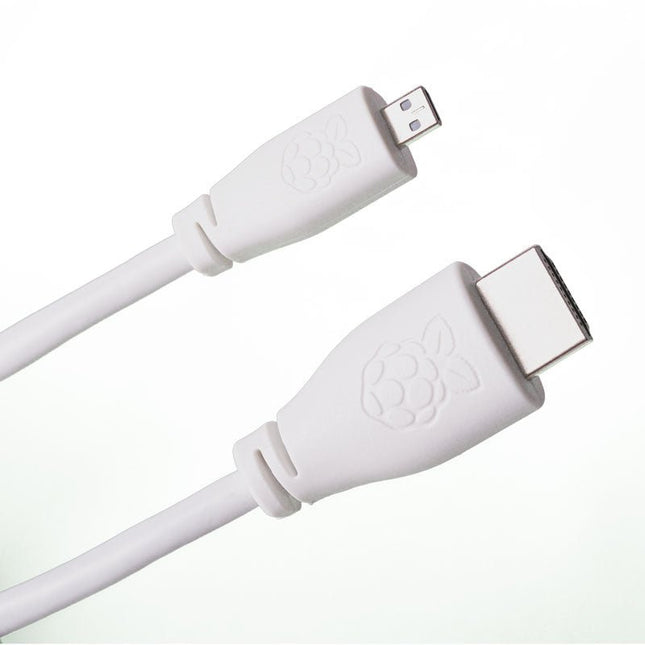
Raspberry Pi Foundation Câble HDMI officiel pour Raspberry Pi (blanc, 1 m)
Le câble officiel Raspberry Pi micro HDMI vers HDMI (A/M) (blanc, 1 m) conçu pour le Raspberry Pi 4 et 5. HDMI 19 broches types D(M) vers HDMI 19 broches types A(M) Câble de 1 m (blanc) Fiches nickelées Conforme à la norme 4Kp60 Conforme à la directive RoHS Isolation de 3 Mohm à 300 VDC, résiste à 300 VDC pendant 0,1 s
€ 6,95€ 3,50
Membres identique
-
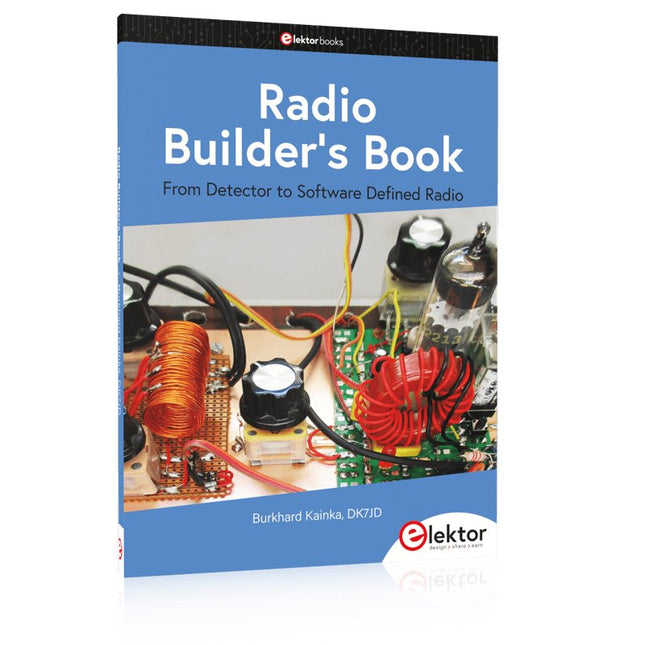
Elektor Publishing Radio Builder's Book
Du détecteur à la radio définie par logiciel La technologie des radiofréquences (RF) est l'un des domaines qui permet encore de mettre en pratique ses propres idées. D'innombrables variantes de circuits avec des objectifs particuliers laissent place à des expériences et des projets significatifs. Beaucoup de choses ne sont tout simplement pas disponibles dans le commerce. Des radios à détecteur de cristal sans source d'alimentation propre, de simples récepteurs à tube avec une touche de nostalgie, les premières tentatives de réception de Software Defined Radio, des récepteurs spéciaux pour radioamateur, tout cela peut être réalisé avec peu d'effort et comme une parfaite introduction à l'électronique RF. Pendant longtemps, la construction radio a été le premier pas vers l’électronique. Il existe cependant d’autres moyens, notamment via les ordinateurs, les microcontrôleurs et le numérique. Cependant, les racines analogiques de l’électronique sont souvent négligées. La technologie radio élémentaire et les expériences faciles à réaliser sont particulièrement adaptées comme domaine d'apprentissage de l'électronique, car vous pouvez ici commencer par les bases les plus simples. Mais le lien avec la technologie numérique moderne est également évident, par exemple lorsqu'il s'agit de méthodes de réglage modernes telles que PLL et DDS ou de radios DSP modernes. Ce livre vise à donner un aperçu et à présenter une collection de projets RF simples. L'auteur souhaite vous aider à développer vos propres idées, à concevoir vos propres récepteurs et à les tester.
€ 39,95
Membres € 35,96
-
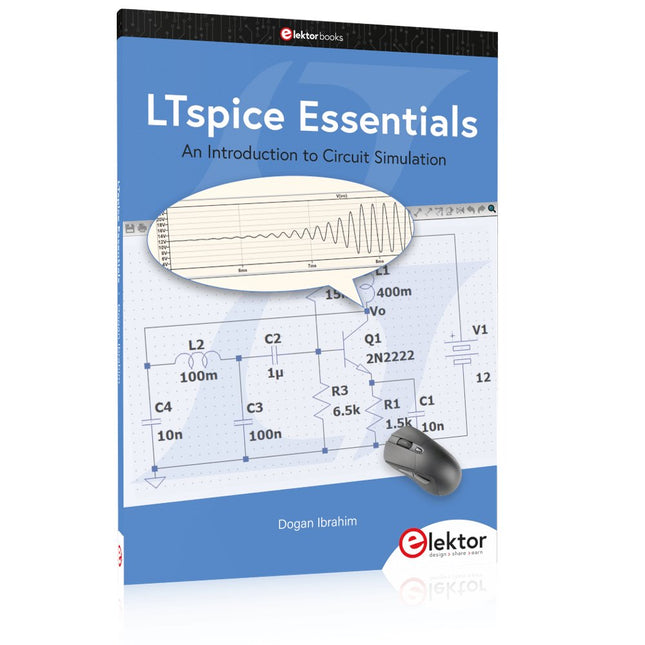
Elektor Publishing LTspice Essentials
An Introduction to Circuit Simulation LTspice, developed by Analog Devices, is a powerful, fast, and free SPICE simulator, schematic capture, and waveform viewer with a large database of components supported by SPICE models from all over the world. Drawing a schematic in LTspice is easy and fast. Thanks to its powerful graphing features, you can visualize the voltages and currents in a circuit, and also the power consumption of its components and much more. This book is about learning to design and simulate electronic circuits using LTspice. Among others, the following topics are treated: DC and AC circuits Signal diodes and Zener diodes Transistor circuits including oscillators Thyristor/SCR, diac, and triac circuits Operational amplifier circuits including oscillators The 555 timer IC Filters Voltage regulators Optocouplers Waveform generation Digital logic simulation including the 74HC family SPICE modeling LTspice is a powerful electronic circuit simulation tool with many features and possibilities. Covering them all in detail is not possible in a book of this size. Therefore, this book presents the most common topics like DC and AC circuit analysis, parameter sweeping, transfer functions, oscillators, graphing, etc. Although this book is an introduction to LTspice, it covers most topics of interest to people engaged in electronic circuit simulation. The book is aimed at electronic/electrical engineers, students, teachers, and hobbyists. Many tested simulation examples are given in the book. Readers do not need to have any computer programming skills, but it will help if they are familiar with basic electronic circuit design and operation principles. Readers who want to dive deeper can find many detailed tutorials, articles, videos, design files, and SPICE circuit models on the Internet. All the simulation examples used in the book are available as files at the webpage of this book. Readers can use these example circuits for learning or modify them for their own applications.
€ 39,95
Membres € 35,96
-
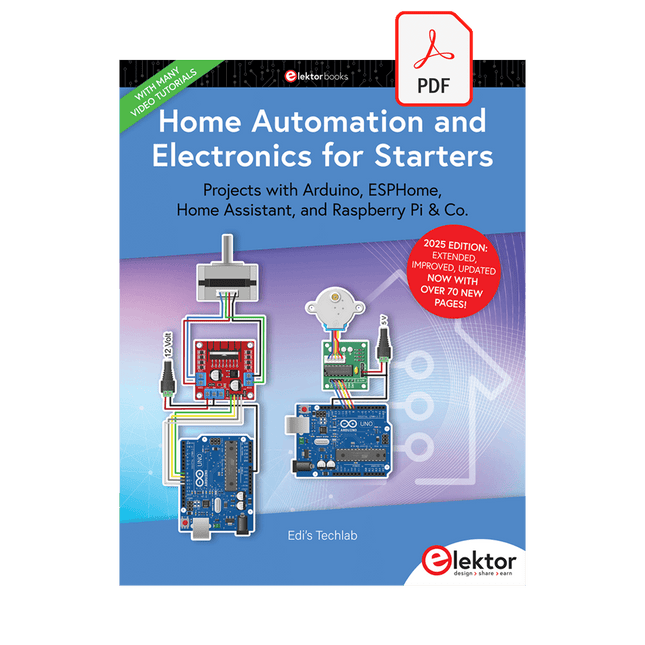
Elektor Digital Home Automation and Electronics for Starters (E-book)
Projets avec Arduino, ESPHome, Home Assistant, et Raspberry Pi & Co. Ce livre électronique contient plusieurs exemples de projets, en commençant par une introduction à l'électronique. Il explique également comment installer Home Assistant sur un Raspberry Pi, comment utiliser des capteurs de climat intérieur pour la température et l'humidité, comment mettre en œuvre le protocole MQTT et d'autres interfaces, et comment utiliser ESPHome pour intégrer des capteurs et des actionneurs dans Home Assistant. De nombreux tutoriels vidéo complètent le livre. Fundamentals of electrical engineering The book begins with an introduction to electrical engineering. You will learn the basics of voltage, current, resistors, diodes and transistors. Arduino and microcontrollers A complete section is dedicated to the Arduino Uno. You will get to know the structure, write your first programs and work on practical examples. Home Assistant and automation You will learn how to set up Home Assistant on a Raspberry Pi and how to use automations, scenes and devices. In addition, Zigbee, MQTT and ESP-NOW – important technologies for home automation – will be discussed. ESP8266, ESP32 and ESP32-CAM The popular ESP microcontrollers are covered in detail. A theoretical introduction is followed by practical projects that show you how to get the most out of these devices. Sensors and actuators The book explains the functionality and application of numerous sensors such as temperature and humidity sensors, motion detectors and RFID readers. For actuators, stepper motors, e-ink displays, servo motors and much more are covered. There are practical application examples for all devices. ESPHome This chapter shows you how to integrate sensors and actuators into Home Assistant without any programming effort. You will be guided step by step through the setup with ESPHome. LEDs and lighting technology In this chapter, you will learn about different types of LEDs and how they can be used. The basics of lighting technology are also explained. Node-RED A whole chapter is dedicated to Node-RED. You will learn the basics of this powerful tool and be guided step by step through its setup and use. Integrated Circuits (ICs) In electronics, there are numerous ICs that make our lives easier. You will get to know the most important ones and apply your knowledge in practical projects. Professional programming Advanced topics such as the correct use of buttons, the use of interrupts and the use of an NTP server for time synchronisation are covered in detail in this chapter. Downloads GitHub
€ 49,95€ 39,95
Membres identique
-
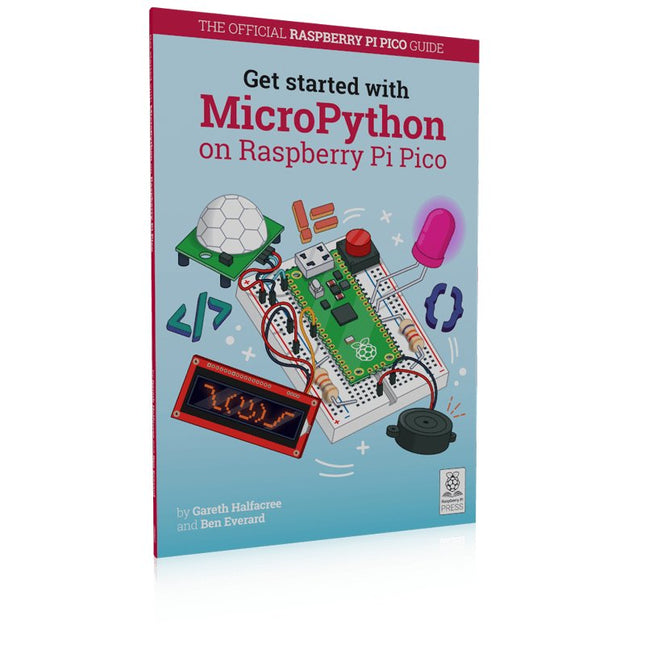
Raspberry Pi Foundation Get Started with MicroPython on Raspberry Pi Pico
In Get Started with MicroPython on Raspberry Pi Pico, you will learn how to use the beginner-friendly language MicroPython to write programs and connect up hardware to make your Raspberry Pi Pico interact with the world around it. Using these skills, you can create your own electro‑mechanical projects, whether for fun or to make your life easier. Microcontrollers, like RP2040 at the heart of Raspberry Pi Pico, are computers stripped back to their bare essentials. You don’t use monitors or keyboards, but program them to take their input from, and send their output to the input/output pins. Using these programmable connections, you can light lights, make noises, send text to screens, and much more. In Get Started with MicroPython on Raspberry Pi Pico, you will learn how to use the beginner-friendly language MicroPython to write programs and connect up hardware to make your Raspberry Pi Pico interact with the world around it. Using these skills, you can create your own electro‑mechanical projects, whether for fun or to make your life easier. The robotic future is here – you just have to build it yourself. We’ll show you how. About the authors Gareth Halfacree is a freelance technology journalist, writer, and former system administrator in the education sector. With a passion for open-source software and hardware, he was an early adopter of the Raspberry Pi platform and has written several publications on its capabilities and flexibility. Ben Everard is a geek who has stumbled into a career that lets him play with new hardware. As the editor of HackSpace magazine, he spends more time than he really should experimenting with the latest (and not-solatest) DIY tech.
€ 19,95€ 9,95
Membres identique
-
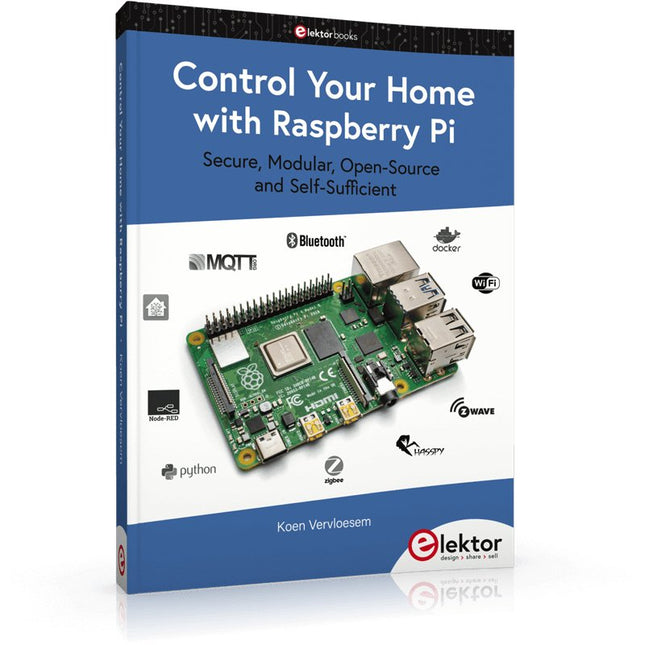
Elektor Publishing Control Your Home with Raspberry Pi
Secure, Modular, Open-Source and Self-Sufficient Ever since the Raspberry Pi was introduced, it has been used by enthusiasts to automate their homes. The Raspberry Pi is a powerful computer in a small package, with lots of interfacing options to control various devices. This book shows you how you can automate your home with a Raspberry Pi. You’ll learn how to use various wireless protocols for home automation, such as Bluetooth, 433.92 MHz radio waves, Z-Wave, and Zigbee. Soon you’ll automate your home with Python, Node-RED, and Home Assistant, and you’ll even be able to speak to your home automation system. All this is done securely, with a modular system, completely open-source, without relying on third-party services. You’re in control of your home, and no one else. At the end of this book, you can install and configure your Raspberry Pi as a highly flexible home automation gateway for protocols of your choice, and link various services with MQTT to make it your own system. This DIY (do it yourself) approach is a bit more laborious than just installing an off-the-shelf home automation system, but in the process, you can learn a lot, and in the end, you know exactly what’s running your house and how to tweak it. This is why you were interested in the Raspberry Pi in the first place, right? Turn your Raspberry Pi into a reliable gateway for various home automation protocols. Make your home automation setup reproducible with Docker Compose. Secure all your network communication with TLS. Create a video surveillance system for your home. Automate your home with Python, Node-RED, Home Assistant and AppDaemon. Securely access your home automation dashboard from remote locations. Use fully offline voice commands in your own language. Downloads Errata on GitHub
€ 44,95
Membres € 40,46
-
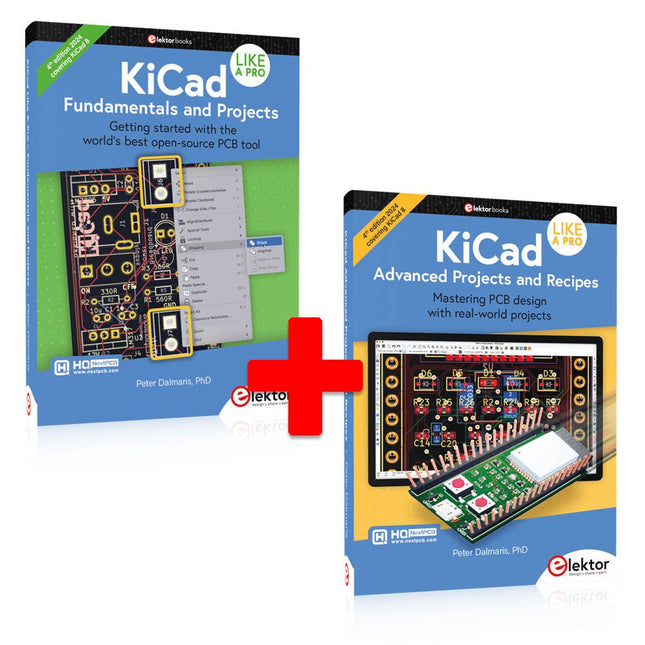
Elektor Bundles KiCad Like A Pro (offre groupée)
Cette offre groupée contient les deux volumes de « KiCad Like a Pro » (4e édition 2024). Dans Fundamentals and Projects (prix normal : 49,95 €), vous apprendrez à utiliser KiCad grâce à une approche pratique, vous aidant à devenir rapidement productif et à commencer à concevoir vos propres cartes. Advanced Projects and Recipes (prix normal : 44,95 €) vous permet de mettre en pratique vos nouvelles compétences KiCad en vous mettant au défi avec une série de projets réels. La dernière version de KiCad, le meilleur outil gratuit de CAO au monde, est dotée de fonctionnalités que l'on ne trouve généralement que dans les outils de CAO commerciaux coûteux. Cette suite d'applications multiplateformes moderne, construite autour d'éditeurs de schémas et de conception, avec des applications auxiliaires, est un outil PCB stable et mature. KiCad 8 est parfait pour les ingénieurs et les créateurs en électronique. Voici les améliorations et fonctionnalités les plus importantes de KiCad 8, à la fois en surface et sous le capot : Interface utilisateur moderne, entièrement repensée par rapport aux versions précédentes Vérificateurs de règles électriques et de conception améliorés et personnalisables Éditeur de thèmes vous permettant de personnaliser KiCad sur votre écran Possibilité d'importer des projets depuis Eagle, CADSTART, etc. API de script Python Simulateur de circuit SPICE intégré amélioré Schémas multi-feuilles Les filtres définissent les éléments sélectionnables Le routeur interactif amélioré vous aide à dessiner des pistes simples et des paires différentielles avec précision Des outils nouveaux ou améliorés pour dessiner des pistes, mesurer des distances, régler les longueurs de piste, etc. Interactif avancé routeur Générateur de nomenclature intégré Visionneuse 3D réaliste avec fonction de lancer de rayons Gouttes d'eau personnalisables Gestionnaire de plug-ins pour une installation rapide de thèmes, de bibliothèques et de fonctionnalités telles que les autorouteurs et les générateurs de nomenclature Le premier livre KiCad Like A Pro – Fundamentals and Projects vous apprendra à utiliser KiCad grâce à une approche pratique. Il vous aidera à devenir productif rapidement et à commencer à concevoir vos propres cartes. Des exemples de projets illustrent les fonctionnalités de base de KiCad, même si vous n'avez aucune connaissance préalable de la conception de PCB. L'auteur décrit l'intégralité du flux de travail, de la saisie des schémas aux subtilités de la finalisation des fichiers pour la production de PCB, et offre des conseils judicieux sur le processus. Le deuxième livre KiCad Like A Pro – Advanced Projects and Recipes vous aidera à mettre en pratique vos nouvelles compétences KiCad en vous mettant au défi dans une série de projets du monde réel. Les projets sont soutenus par un ensemble complet de recettes avec des instructions détaillées sur la façon de réaliser une variété de tâches simples et complexes. Concevez les PCB pour une alimentation solaire, une matrice de LED, un enregistreur de données alimenté par Arduino et une carte ESP32 personnalisée. Comprenez les détails les plus fins du routeur interactif, comment gérer les équipes de projet KiCad avec Git, comment utiliser un autorouter sur des PCB à 2 et 4 couches, et bien plus encore.
€ 104,95€ 84,95
Membres identique
-
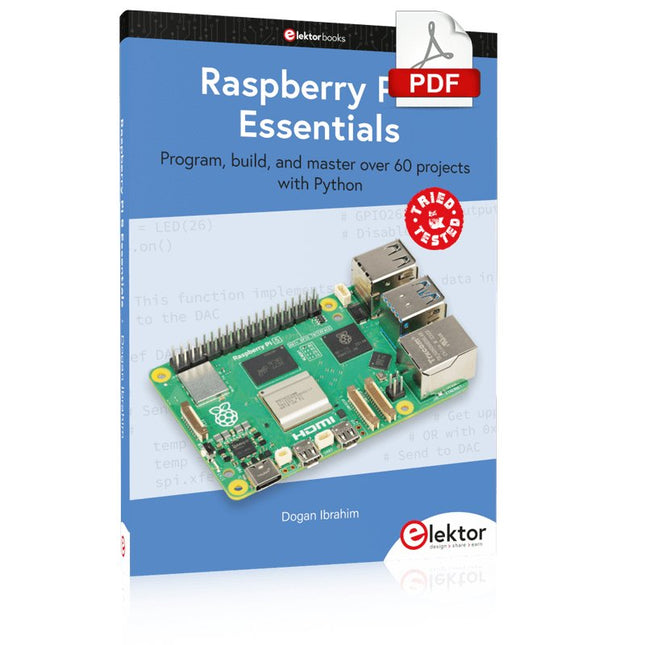
Elektor Digital Raspberry Pi 5 Essentials (E-book)
Program, build, and master over 60 projects with Python The Raspberry Pi 5 is the latest single-board computer from the Raspberry Pi Foundation. It can be used in many applications, such as in audio and video media centers, as a desktop computer, in industrial controllers, robotics, and in many domestic and commercial applications. In addition to the well-established features found in other Raspberry Pi computers, the Raspberry Pi 5 offers Wi-Fi and Bluetooth (classic and BLE), which makes it a perfect match for IoT as well as in remote and Internet-based control and monitoring applications. It is now possible to develop many real-time projects such as audio digital signal processing, real-time digital filtering, real-time digital control and monitoring, and many other real-time operations using this tiny powerhouse. The book starts with an introduction to the Raspberry Pi 5 computer and covers the important topics of accessing the computer locally and remotely. Use of the console language commands as well as accessing and using the desktop GUI are described with working examples. The remaining parts of the book cover many Raspberry Pi 5-based hardware projects using components and devices such as LEDs and buzzers LCDs Ultrasonic sensors Temperature and atmospheric pressure sensors The Sense HAT Camera modules Example projects are given using Wi-Fi and Bluetooth modules to send and receive data from smartphones and PCs, and sending real-time temperature and atmospheric pressure data to the cloud. All projects given in the book have been fully tested for correct operation. Only basic programming and electronics experience are required to follow the projects. Brief descriptions, block diagrams, detailed circuit diagrams, and full Python program listings are given for all projects described.
€ 32,95
Membres € 26,36
-
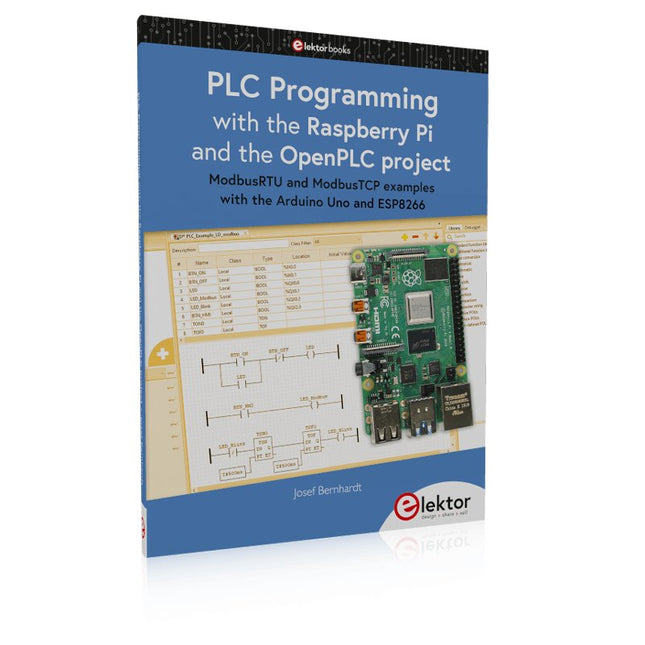
Elektor Publishing PLC Programming with the Raspberry Pi and the OpenPLC Project
ModbusRTU and ModbusTCP examples with the Arduino Uno and ESP8266 Introduction to PLC programming with OpenPLC, the first fully open source Programmable Logic Controller on the Raspberry Pi, and Modbus examples with Arduino Uno and ESP8266 PLC programming is very common in industry and home automation. This book describes how the Raspberry Pi 4 can be used as a Programmable Logic Controller. Before taking you into the programming, the author starts with the software installation on the Raspberry Pi and the PLC editor on the PC, followed by a description of the hardware. You'll then find interesting examples in the different programming languages complying with the IEC 61131-3 standard. This manual also explains in detail how to use the PLC editor and how to load and execute the programs on the Raspberry Pi. All IEC languages are explained with examples, starting with LD (Ladder Diagram) over ST (Structured Control Language) to SFC (Special Function Chart). All examples can be downloaded from the author's website. Networking gets thorough attention too. The Arduino Uno and the ESP8266 are programmed as ModbusRTU or ModbusTCP modules to get access to external peripherals, reading sensors and switching electrical loads. I/O circuits complying with the 24 V industry standard may also be of interest for the reader. The book ends with an overview of commands for ST and LD. After reading the book, the reader will be able to create his own controllers with the Raspberry Pi.
€ 39,95
Membres € 35,96
-
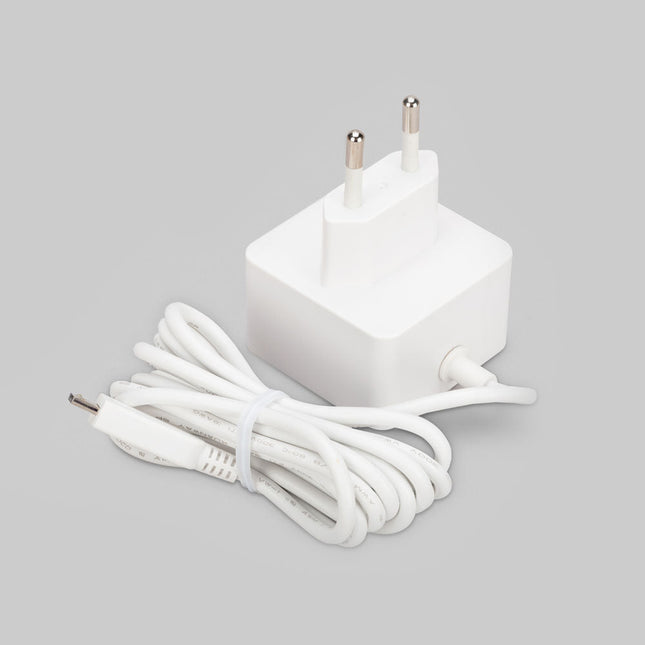
Raspberry Pi Foundation Alimentation Micro USB officielle pour Raspberry Pi
Alimentation Micro-USB officielle pour Raspberry Pi (12,5 W) Entrée : 100-240 V CA Sortie : alimentation 5,1 V / 2,5 A Connecteur : micro-USB Longueur : 1,5 m
€ 9,95
Membres identique
-
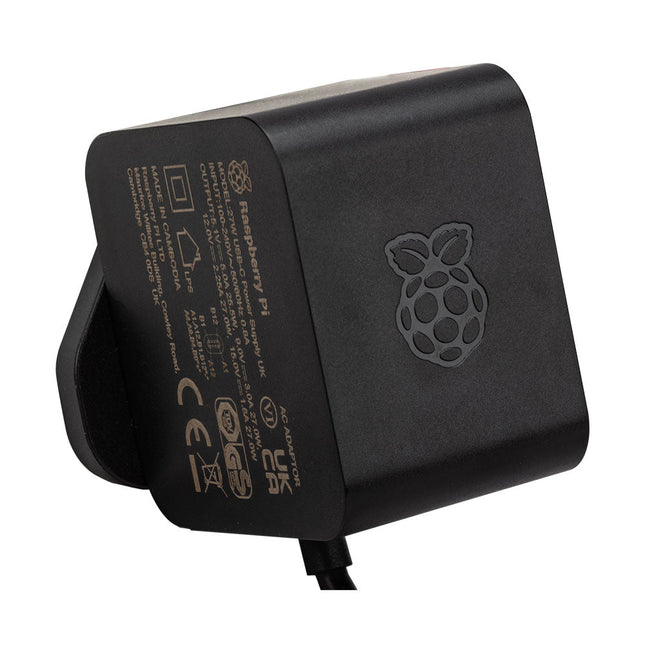
Raspberry Pi Foundation Alimentation officielle 27 W pour Raspberry Pi 5 (UE, noir)
L'alimentation USB-C Raspberry Pi 27 W PD est conçue spécifiquement pour alimenter le Raspberry Pi 5. Elle est également capable de délivrer 5 V/3 A, 9 V/3 A, 12 V/2,25 A, 15 V/1,8 A. .aux produits compatibles PD, ce qui en fait une alimentation efficace et rentable pour de nombreuses applications générales, telles que le chargement de smartphones et de tablettes. Caractéristiques Saisir 100-240 VCA Sortir 5 A à 5,1 V, 3 A à 9 V, 2,25 A à 12 V, 1,8 A à 15 V Connecteur USB-C Longueur 1,2 m Couleur Noir Région UE
€ 13,95
Membres identique
-
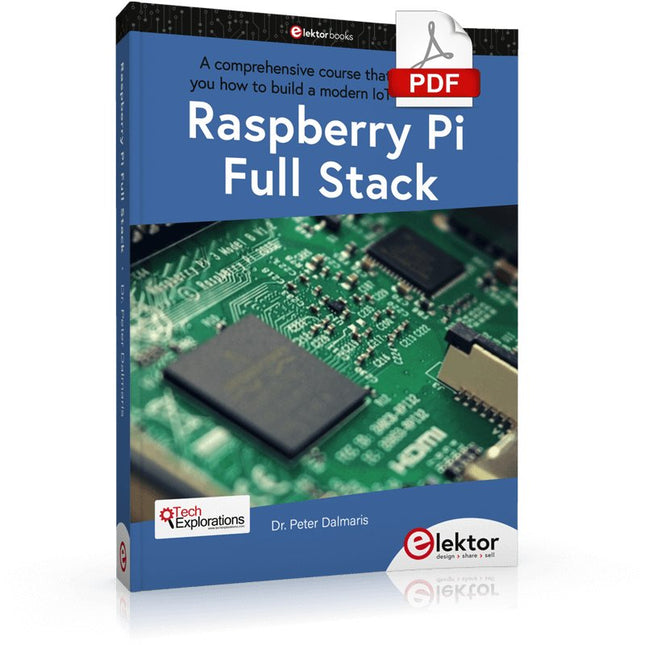
Elektor Digital Raspberry Pi Full Stack (E-book)
Ce livre vous emmène dans une visite éclair du développement d'applications Web full-stack à l'aide de Raspberry Pi. Vous apprendrez à créer une application à partir de zéro. Vous acquerrez de l'expérience et des connaissances sur les technologies, notamment : Le système d'exploitation Linux et la ligne de commande. Le langage de programmation Python. Les broches d'entrée-sortie à usage général (GPIO) du Raspberry Pi. Le serveur Web Nginx. Micro-framework Flask Python pour les applications Web. JQuery et CSS pour créer des interfaces utilisateur. Gérer les fuseaux horaires. Création de graphiques avec Plotly et Google Charts. Enregistrement des données avec Google Sheet. Développement d'applets avec IFTTT. Sécuriser votre application avec SSL. Recevez des messages texte sur votre téléphone avec Twilio. Ce livre vous apprend également comment configurer à distance un nœud de capteur Arduino sans fil et en collecter des données. Votre application Web Raspberry Pi sera capable de traiter les données du nœud Arduino de la même manière qu'elle traite les données de son capteur intégré. Raspberry Pi Full Stack vous enseigne de nombreuses compétences essentielles à la création d'applications Web et Internet des objets. L'application que vous construirez dans ce projet est une plate-forme sur laquelle vous pourrez vous développer. Ce n'est que le début de ce que vous pouvez faire avec un Raspberry Pi et les composants logiciels et matériels que vous apprendrez. Ce livre est soutenu par l'auteur à travers un espace de discussion dédié.
€ 34,95
Membres € 27,96
-
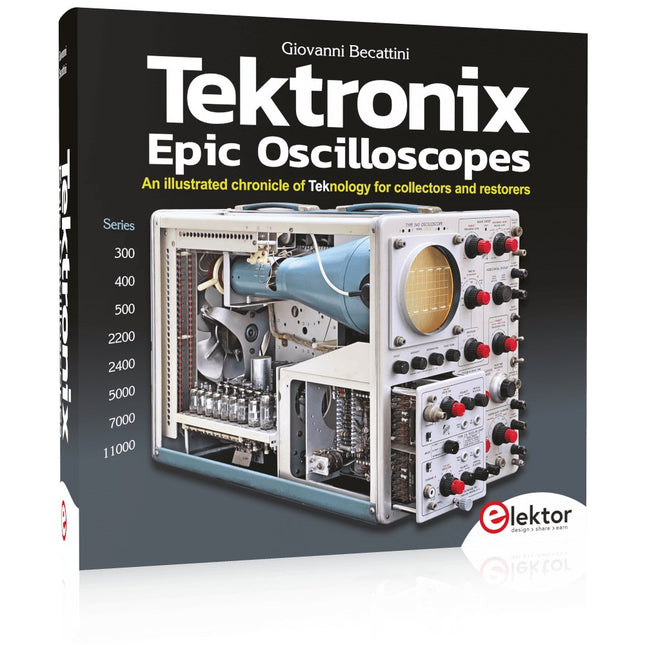
Elektor Publishing Tektronix Epic Oscilloscopes
Une chronique illustrée de la teknologie pour les collectionneurs et les restaurateurs Les oscilloscopes ont apporté une contribution majeure à l'avancement des connaissances humaines, non seulement en électronique, mais dans toutes les sciences, chaque fois qu'une grandeur physique peut être convertie en un signal électrique temporel. Ce livre retrace l'histoire d'un instrument crucial à travers de nombreux produits Tektronix. C’est la société qui a inventé et breveté la plupart des fonctions présentes aujourd’hui dans tous les oscilloscopes. Tek est et sera toujours synonyme d'oscilloscope. En près de 600 pages, avec des centaines de magnifiques photos, schémas, anecdotes et données techniques, vous voyagerez à travers l'histoire de Tektronix dans une superbe édition collector d'un point de vue technique. L’auteur n’a pas peur de mettre la main à la pâte en restaurant son propre équipement Tek. Le voyage commence au début des années 1950. Il se termine dans les années 90, après avoir exploré les tenants et les aboutissants des modèles les plus intéressants des séries 300, 400, 500, 5000, 7000 et 11000, des tubes aux technologies hybrides avancées. Téléchargements NOUVEAU : Supplément gratuit (136 pages, 401 Mo)
€ 79,95
Membres € 71,96
-
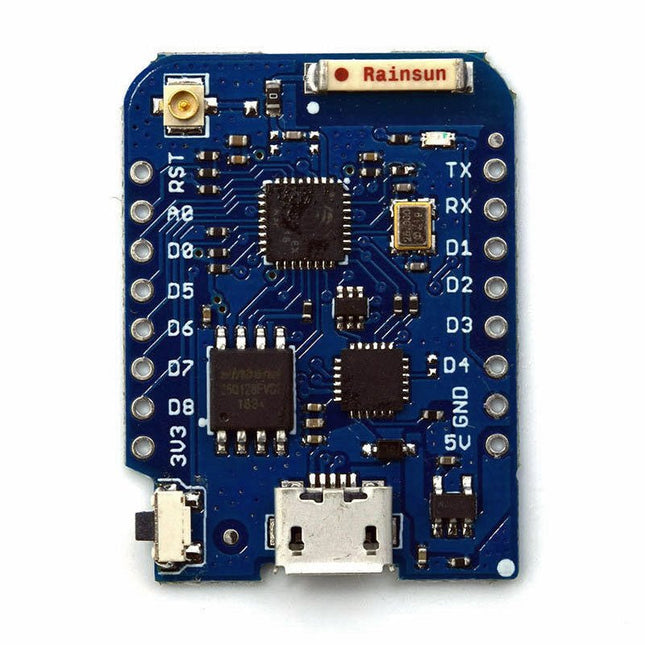
Wemos WeMos D1 mini Pro – ESP8266 based WiFi Module
Cette mini carte WiFi dispose d'un flash de 16 Mo, d'un connecteur d'antenne externe et d'une antenne en céramique intégrée basée sur ESP8266EX. Caractéristiques 11 broches d'entrée/sortie numérique Interruption/pwm/I²C/un fil 1 entrée analogique (entrée 3,2 V max) 16 Mo de mémoire flash Connecteur d'antenne externe Antenne céramique intégrée CI USB-VERS-UART CP2104 Caractéristiques Tension de fonctionnement 3,3 V Broches d'E/S numériques 11 Broches d'entrée analogique 1 (3,2 V maximum) Vitesse de l'horloge 80/160MHz Éclair 16 Mo Taille 34,2 x 25,6 mm Poids 3g Configuration des broches Épingle Fonction Broche ESP8266 RX RXD RXD A0 Entrée analogique, max 3,2 V A0 D0 IO GPIO16 D1 E/S, SCL GPIO5 D2 IO, SDA GPIO4 D3 IO, 10k Pull-up GPIO0 D4 IO, 10k Pullup, BUILTIN_LED GPIO2 D5 IO, SCK GPIO14 D6 IO, MISO GPIO12 J7 IO, MOSI GPIO13 D8 IO, 10k Pull vers le bas, SS GPIO15 g Sol GND 5V 5 V - 3V3 3,3 V 3,3 V TVD Réinitialiser TVD Inclus 1x WeMos D1 mini Pro (basé sur ESP8266EX) 2x connecteur à broches (court) 2x barrette de connexion femelle (courte) 2x barrette de connexion femelle (longue)
€ 14,95€ 7,50
Membres identique
-
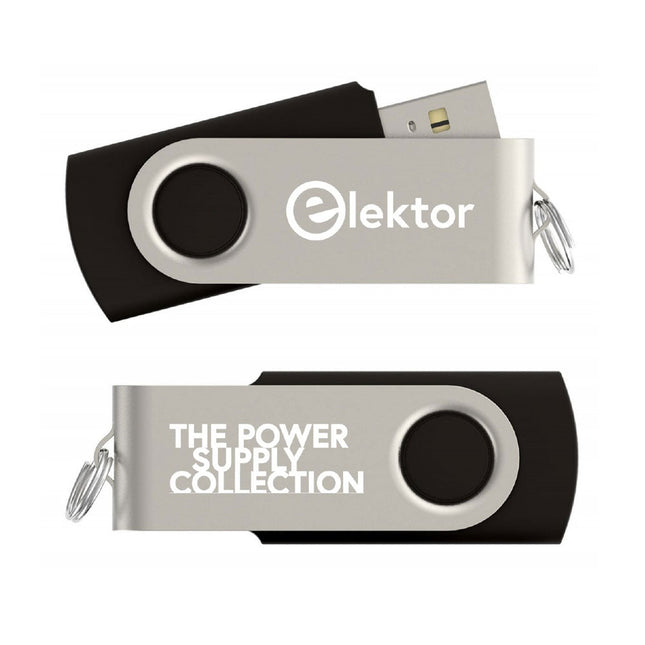
Elektor Classics The Elektor Power Supply Collection (clé USB)
Plus de 200 circuits d'alimentation électrique « maison » Cette clé USB contient plus de 200 circuits d'alimentation électrique extraits des numéros d'Elektor de 2001 à 2022. La fonction de recherche d'articles vous permet d'effectuer des recherches en texte intégral. Les résultats sont toujours affichés sous forme de documents PDF préformatés. Quelques points forts convertisseur Cuk Automatic Battery Switchover LED de contrôle de piles alimentation de table numérique chargeur de pile Lithium-Ion chargeur à cellules solaires fusible électronique régulateur haute tension alimentation par le port USB convertisseur élévateur pour LED Battery Management et bien plus encore... Sur la clé, vous trouverez également un dossier avec un contenu supplémentaire tel que des schémas de circuits imprimés, des fichiers Gerber et des logiciels.
€ 49,95€ 24,95
Membres identique
-
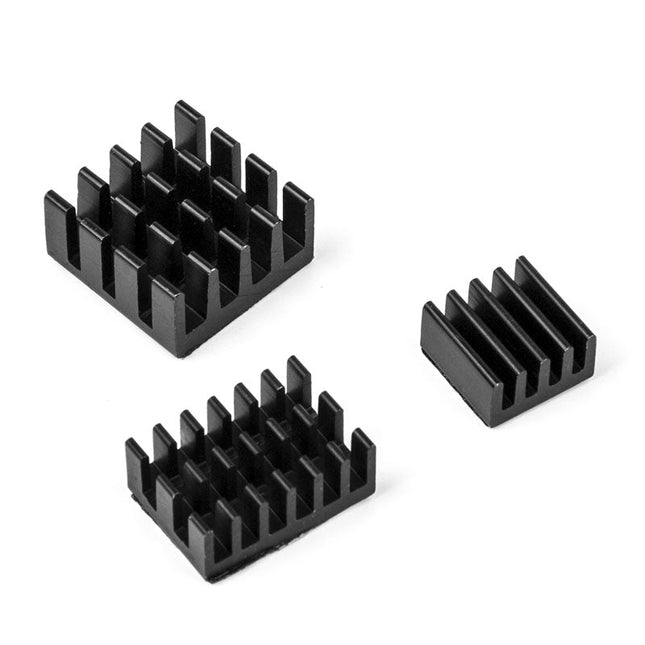
Kuongshun Kit de dissipateurs thermiques pour Raspberry Pi (noir)
Jeu de 3 dissipateurs thermiques en aluminium pour Raspberry Pi 4 en 5 Contenu 1x 14x14x6 mm 1x 15x10x5 mm 1x 8,8x8,8x5 mm
€ 3,95€ 2,95
Membres identique
-

Elektor Digital Elektor Special: Power Supplies and Batteries (PDF)
Quelles que soient les méthodes ou même les moyens financiers dont vous disposez pour faire fonctionner vos circuits, l'alimentation électrique doit figurer en bonne place, voire numéro un, dans vos considérations. Le bloc de conception simplement appelé « alimentation » est extrêmement sous-estimé, tant dans la création que dans la réparation de produits électroniques. Pourtant, le « PSU » présente une énorme diversité et se présente sous des formes très différentes comme AC/DC, générateur, batterie (rechargeable ou non), panneau photovoltaïque, de table, linéaire ou à découpage, pour n'en citer que quelques-uns. Les plages de sortie sont également stupéfiantes, du nano-ampère au kiloampère et il en va de même pour les tensions. Ce spécial couvre les caractéristiques et les aspects de conception des alimentations. Contenu Les bases Gestion de la batterie Ce qu'il faut savoir lors de l'utilisation de piles (au lithium). Alimentation à tension fixe utilisant des régulateurs linéaires Le meilleur résultat juste après les piles. Récupération d'énergie lumineuse Un petit panneau solaire est utilisé dans un projet de récupération d'énergie pour gérer et charger quatre cellules AAA. Conception de l'adaptateur alimenté par secteur Circuits de base et conseils pour transformateurs, redressement, filtrage et stabilisation. Démarrage progressif LM317 L'impulsion de courant d'appel élevée doit être évitée. Redresseurs contrôlables Quelques suggestions pour maintenir la perte de puissance dans le régulateur linéaire aussi faible que possible. Composants Feuille de travail : Les régulateurs de tension LM117 / LM217 / LM317 Supercapsules Basse tension mais beaucoup de courant… ou pas ? Commentaires Kit d'alimentation de table JOY-iT RD6006 Charge électronique CC programmable Siglent SDL1020X Projets Centrale électrique du balcon Balcon solaire DIY = retour sur investissement rapide ! Kit de compresseur LiPo DIY De l'artisanat au marché de masse Thyristor MOSFET à double anode Plus rapide et moins coûteux que l'ancien SCR Presse-agrumes à batterie Ne jetez pas, pressez ! Alimentation haute tension avec traceur de courbe Générez des tensions jusqu'à 400 V et tracez des courbes caractéristiques pour les vannes et les transistors Alimentation haute tension pour RIAA Pour préamplis à lampes RIAA et autres applications. MicroApprovisionnement Une alimentation de laboratoire pour les appareils connectés Alimentation fantôme utilisant des condensateurs commutés Tripleur de tension utilisant trois circuits intégrés L'alimentation à découpage SMPS800RE pour l'Elektor Fortissimo-100 Fiable, léger et abordable Démarrage progressif pour bloc d'alimentation Soyez gentil avec votre alimentation – et sa charge UniLab 2 Alimentation de laboratoire compacte à découpage 0-30 V, 3 A Conseils Démarrage progressif pour les régulateurs à découpage abaisseurs Limite de courant de perte faible Batterie externe Surprise Un terrain virtuel Mainteneur de batterie Déchargeur de batterie Connexion des régulateurs de tension en parallèle
€ 11,95
Membres € 10,76
-
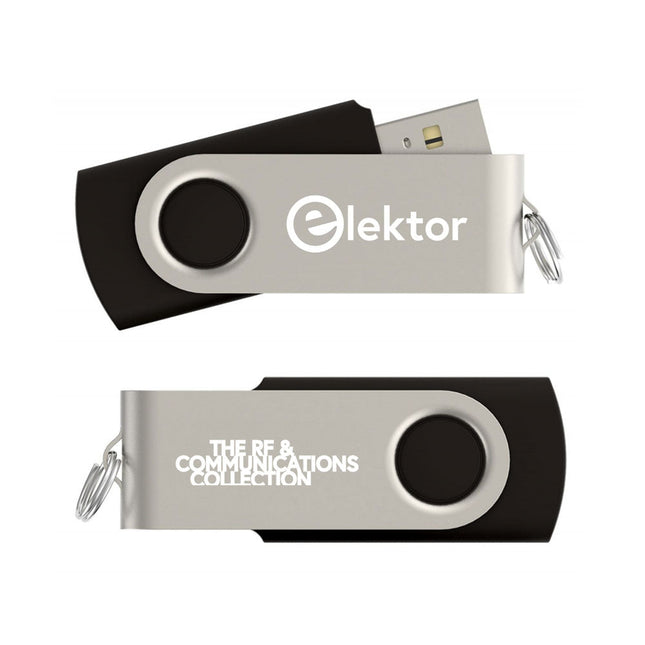
The RF & Communications Collection (clé USB)
Cette clé USB contient une sélection de plus de 350 articles sur les RF, la radio et la communication publiés dans le magazine Elektor. Le contenu comprend à la fois des articles de fond et des projets portant sur les sujets suivants : Circuits de base liés à la radio ainsi que circuits plus complexes comme des filtres, des oscillateurs et des amplificateurs. Conception, construction et théorie des antennes pour transmettre et recevoir efficacement des signaux radio. Conception et analyse de circuits RF, notamment filtres, mélangeurs, PLL et synthétiseurs de fréquence. Outils et techniques pour prédire les chemins de propagation des ondes radio et mesurer la force du signal RF. Techniques de traitement des signaux numériques dans les systèmes RF, y compris les méthodes de modulation et de démodulation. Projets sur les récepteurs radio, AM, FM, SSB, CW, DRM, DAB, DAB+, Software Defined Radio, et plus encore. Projets sur Wi-Fi, Bluetooth, LoRaWAN, et plus encore. Vous pouvez utiliser la fonction de recherche d'articles pour localiser un contenu spécifique dans le texte intégral. Les résultats sont toujours affichés sous forme de documents PDF préformatés. Vous pouvez utiliser Adobe Reader pour parcourir des articles et utiliser les fonctions de recherche intégrées d'Adobe Reader pour rechercher des instances de mots et d'expressions individuels.
€ 49,95€ 24,95
-

Elektor Digital Nucleo Boards Programming with the STM32CubeIDE (E-book)
Hands-on in more than 50 projects STM32 Nucleo family of processors are manufactured by STMicroelectronics. These are low-cost ARM microcontroller development boards. This book is about developing projects using the popular STM32CubeIDE software with the Nucleo-L476RG development board. In the early Chapters of the book the architecture of the Nucleo family is briefly described. The book covers many projects using most features of the Nucleo-L476RG development board where the full software listings for the STM32CubeIDE are given for each project together with extensive descriptions. The projects range from simple flashing LEDs to more complex projects using modules, devices, and libraries such as GPIO, ADC, DAC, I²C, SPI, LCD, DMA, analogue inputs, power management, X-CUBE-MEMS1 library, DEBUGGING, and others. In addition, several projects are given using the popular Nucleo Expansion Boards. These Expansion Boards plug on top of the Nucleo development boards and provide sensors, relays, accelerometers, gyroscopes, Wi-Fi, and many others. Using an expansion board together with the X-CUBE-MEMS1 library simplifies the task of project development considerably. All the projects in the book have been tested and are working. The following sub-headings are given for each project: Project Title, Description, Aim, Block Diagram, Circuit Diagram, and Program Listing for the STM32CubeIDE. In this book you will learn about STM32 microcontroller architecture; the Nucleo-L476RG development board in projects using the STM32CubeIDE integrated software development tool; external and internal interrupts and DMA; DEBUG, a program developed using the STM32CubeIDE; the MCU in Sleep, Stop, and in Standby modes; Nucleo Expansion Boards with the Nucleo development boards. What you need a PC with Internet connection and a USB port; STM32CubeIDE software (available at STMicroelectronics website free of charge) the project source files, available from the book’s webpage hosted by Elektor; Nucleo-L476RG development board; simple electronic devices such as LEDs, temperature sensor, I²C and SPI chips, and a few more; Nucleo Expansion Boards (optional).
€ 39,95
Membres € 31,96
-
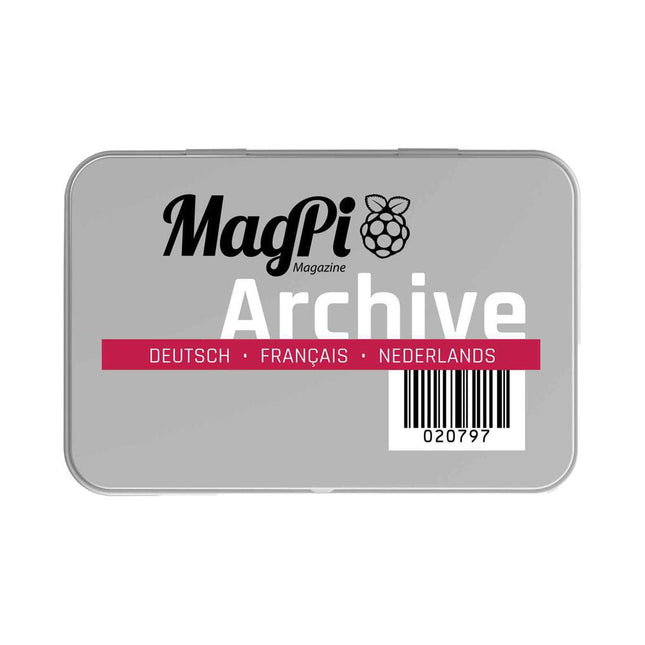
Archives de MagPi (clé USB)
Plus de 6 ans de MagPi (de 2018 à 2024) sur clé USB Cette clé USB contient tous les numéros de MagPi en français des années 2018 à janvier-février 2024. La dernière édition (mars-avril 2024) peut être téléchargée gratuitement pour tout le monde ici. MagPi est le magazine officiel de la Fondation Raspberry Pi. Il contient des bancs d’essai de nouveaux produits, de nombreux tutoriels et un grand nombre de projets choisis pour leur intérêt et leur originalité.
€ 69,95€ 19,95
Membres identique
-
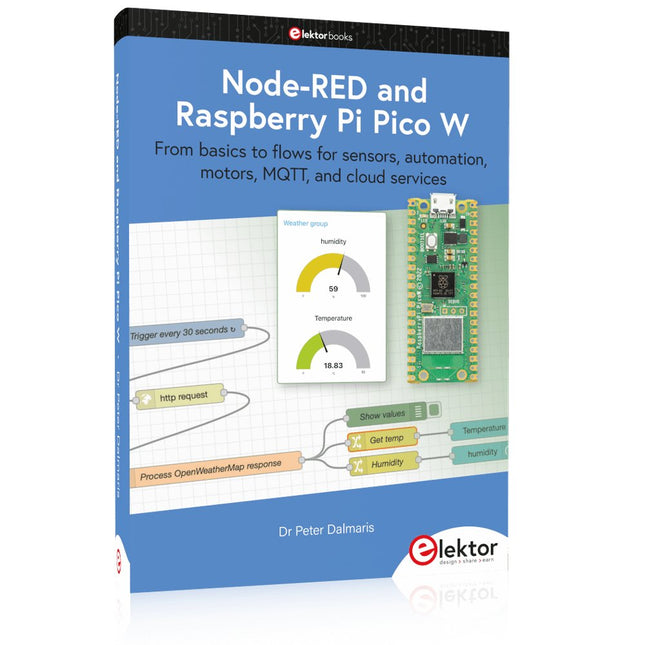
Elektor Publishing Node-RED and Raspberry Pi Pico W
From basics to flows for sensors, automation, motors, MQTT, and cloud services This book is a learning guide and a reference. Use it to learn Node-RED, Raspberry Pi Pico W, and MicroPython, and add these state-of-the-art tools to your technology toolkit. It will introduce you to virtual machines, Docker, and MySQL in support of IoT projects based on Node-RED and the Raspberry Pi Pico W. This book combines several elements into a platform that powers the development of modern Internet of Things applications. These elements are a flow-based server, a WiFi-enabled microcontroller, a high-level programming language, and a deployment technology. Combining these elements gives you the tools you need to create automation systems at any scale. From home automation to industrial automation, this book will help you get started. Node-RED is an open-source flow-based development tool that makes it easy to wire together devices, APIs, and online services. Drag and drop nodes to create a flowchart that turns on your lights at sunset or sends you an email when a sensor detects movement. Raspberry Pi Pico W is a version of the Raspberry Pi Pico with added 802.11n Wi-Fi capability. It is an ideal device for physical computing tasks and an excellent match to the Node-RED. Quick book facts Project-based learning approach. Assumes no prior knowledge of flow-based programming tools. Learn to use essential infrastructure tools in your projects, such as virtual machines, Docker, MySQL and useful web APIs such as Google Sheets and OpenWeatherMap. Dozens of mini-projects supported by photographs, wiring schematics, and source code. Get these from the book GitHub repository. Step-by-step instructions on everything. All experiments are based on the Raspberry Pi Pico W. A Wi-Fi network is required for all projects. Hardware (including the Raspberry Pi Pico W) is available as a kit. Downloads GitHub
€ 49,95
Membres € 44,96
-
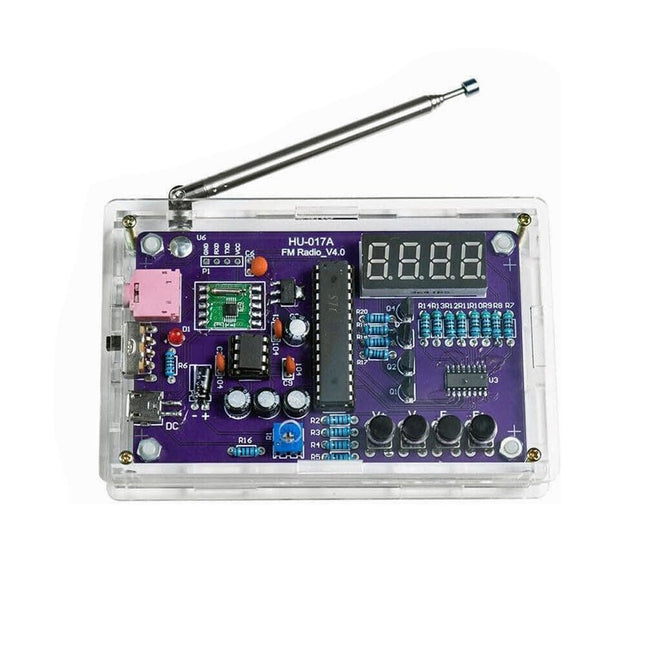
Generic Kit radio FM
Ce kit à monter soi-même (HU-017A) est un récepteur radio FM sans fil possédant un affichage à 4 chiffres et 7 segments. Il fonctionne dans la bande de fréquence mondiale de réception FM de 87,0-108,0 MHz, ce qui permet de l'utiliser dans n'importe quel pays ou région. Le kit offre deux modes d'alimentation, ce qui vous permet de l'utiliser à la maison comme aussi en extérieur. Ce montage électronique fait maison vous aidera à comprendre les circuits et à perfectionner vos compétences en matière de soudage. Caractéristiques Radio FM 87,0-108,0 MHz : Processeur de données FM RDA5807 intégré avec une bande de fréquence de réception FM standard. La fréquence FM peut être réglée à l'aide des touches F+ et F-. Réglage du volume : Deux méthodes de réglage du volume – bouton et potentiomètre. Ils proposent 15 niveaux de volume. Sortie audio active et passive : Le kit dispose d'un amplificateur de puissance intégré de 0,5 W pour alimenter directement des haut-parleurs de 8 Ω. Il émet également des signaux audio vers des casques ou des haut-parleurs dotés d'interfaces AUX, ce qui permet une écoute personnelle ou public de l'audio FM. Equipé d'une antenne FM dédiée de 25 cm et d'un afficheur (en rouge) à 4 chiffres et 7 segments pour l'affichage en temps réel de la fréquence radio FM. Le boîtier transparent acrylique protège le circuit imprimé interne. Deux méthodes d'alimentation sont prises en charge : 5 V USB et 2 piles de 1,5 V (AA). Soudage à la main : Le kit est livré avec divers composants qui doivent être installés manuellement. Ceci permet d'exercer et de perfectionner ses compétences en matière de soudure, et est également adapté aux amateurs d'électronique, aux débutants ainsi qu'à des fins d'éducation. Spécifications Tension d'exploitation DC 3 V/5 V Impédance de sortie 8 Ω Puissance de sortie 0,5 W Canal de sortie Mono Fréquence de réception 87.0 MHz~108.0 MHz Précision de la féquence 0.1 MHz Température d'exploitation −40°C à +85°C Taux d'humidité d'exploitation 5% à 95% d'humidité relative Dimensions 107 x 70 x 23 mm IMPORTANT : Retirez les piles lorsque vous alimentez la radio via USB ! Inclus 1x circuit imprimé 1x récepteur FM RDA5807M 1x microcontrôleur STC15W404AS 1x socle pour IC 1x registreà décalage 74HC595D 1x amplificateur TDA2822M 1x socle pour IC 1x convertisseur de tension 3,3 V AMS1117 18x résistances à film métallique 1x potentiomètre 4x condensateurs céramiques 5x condensateurs électrolytiques 4x transistors S8550 1x DEL rouge 1x afficheur à 4 chiffres et 7 segments 1x interrupteur à bascule 1x prise CMS Micro USB 1x antenne radio 1x prise audio AUX 4x boutons noirs 4x capuchons de bouton 1x haut-parleur 0,5 W/8 Ω 1x fil rouge/noir 2x adhésifs doubles face 1x boîtier pour piles AA 1x câble USB 6x plaquettes acryliques 4x vis entretoises en nylon 4x vis M3 4x écrous M3 4x vis M2x22 mm 1x vis M2x6 mm 5x écrous M2
€ 29,95
Membres € 26,96
-
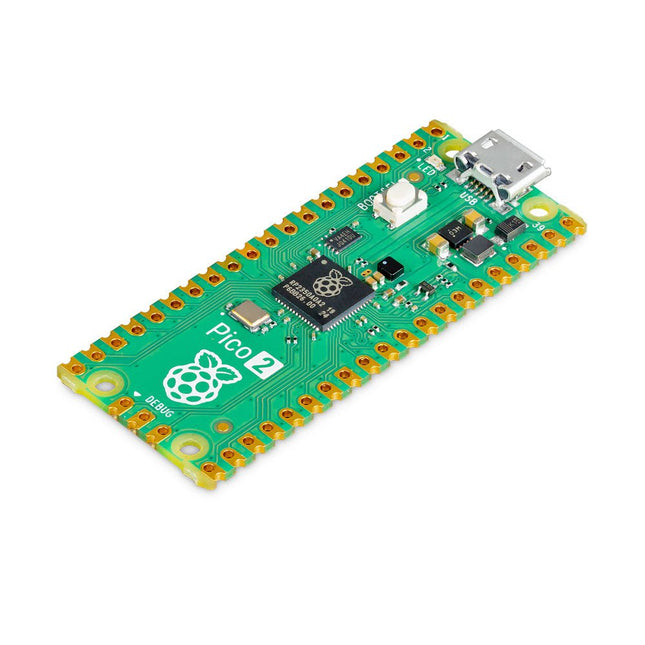
Raspberry Pi Foundation Raspberry Pi Pico 2
Le Raspberry Pi Pico 2 est une nouvelle carte microcontrôleur de la Raspberry Pi Foundation, basée sur le RP2350. Il présente une vitesse d'horloge de cœur plus élevée, le double de la SRAM sur puce, le double de la mémoire flash intégrée, des cœurs Arm plus puissants, des cœurs RISC-V en option, de nouvelles fonctionnalités de sécurité et des capacités d'interface améliorées. Le Raspberry Pi Pico 2 offre une amélioration significative des performances et des fonctionnalités tout en conservant la compatibilité matérielle et logicielle avec les membres précédents de la série Raspberry Pi Pico. Le RP2350 fournit une architecture de sécurité complète construite autour d'Arm TrustZone pour Cortex-M. Il intègre un démarrage signé, 8 Ko d'OTP antifusible pour le stockage des clés, une accélération SHA-256, un TRNG matériel et des détecteurs de problèmes rapides. La capacité unique à double cœur et à double architecture du RP2350 permet aux utilisateurs de choisir entre une paire de cœurs Arm Cortex-M33 standard et une paire de cœurs Hazard3 RISC-V à matériel ouvert. Programmable en C/C++ et Python, et pris en charge par une documentation détaillée, le Raspberry Pi Pico 2 est la carte microcontrôleur idéale pour les passionnés et les développeurs professionnels. Spécifications Processeur Processeurs Dual Arm Cortex-M33 ou double RISC-V Hazard3 à 150 MHz Mémoire 520 Ko de SRAM sur puce ; Flash QSPI intégré de 4 Mo Interfaces 26 broches GPIO polyvalentes, dont 4 pouvant être utilisées pour AD Périphériques 2x UART 2x Contrôleurs SPI 2x Contrôleurs I²C 24x Canaux PWM 1x Contrôleur USB 1.1 et PHY, avec prise en charge des hôtes et des périphériques 12x Machines à états PIO Puissance d'entrée 1,8-5,5 V CC Dimensions 21 x 51 mm Téléchargements Datasheet (Pico 2) Datasheet (RP2350)
€ 5,95
Membres identique























